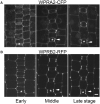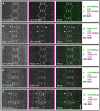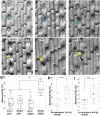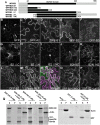Polarly localized WPR proteins interact with PAN receptors and the actin cytoskeleton during maize stomatal development
- PMID: 36227066
- PMCID: PMC9806561
- DOI: 10.1093/plcell/koac301
Polarly localized WPR proteins interact with PAN receptors and the actin cytoskeleton during maize stomatal development
Abstract
Polarization of cells prior to asymmetric cell division is crucial for correct cell divisions, cell fate, and tissue patterning. In maize (Zea mays) stomatal development, the polarization of subsidiary mother cells (SMCs) prior to asymmetric division is controlled by the BRICK (BRK)-PANGLOSS (PAN)-RHO FAMILY GTPASE (ROP) pathway. Two catalytically inactive receptor-like kinases, PAN2 and PAN1, are required for correct division plane positioning. Proteins in the BRK-PAN-ROP pathway are polarized in SMCs, with the polarization of each protein dependent on the previous one. As most of the known proteins in this pathway do not physically interact, possible interactors that might participate in the pathway are yet to be described. We identified WEAK CHLOROPLAST MOVEMENT UNDER BLUE LIGHT 1 (WEB1)/PLASTID MOVEMENT IMPAIRED 2 (PMI2)-RELATED (WPR) proteins as players during SMC polarization in maize. WPRs physically interact with PAN receptors and polarly accumulate in SMCs. The polarized localization of WPR proteins depends on PAN2 but not PAN1. CRISPR-Cas9-induced mutations result in division plane defects in SMCs, and ectopic expression of WPR-RFP results in stomatal defects and alterations to the actin cytoskeleton. We show that certain WPR proteins directly interact with F-actin through their N-terminus. Our data implicate WPR proteins as potentially regulating actin filaments, providing insight into their molecular function. These results demonstrate that WPR proteins are important for cell polarization.
© American Society of Plant Biologists 2022. All rights reserved. For permissions, please email: journals.permissions@oup.com.
Figures







Comment in
-
Forming the queue: A role for WPR proteins in establishing cell polarity.Plant Cell. 2023 Jan 2;35(1):343-344. doi: 10.1093/plcell/koac310. Plant Cell. 2023. PMID: 36282993 Free PMC article. No abstract available.
Similar articles
-
Identification of PAN2 by quantitative proteomics as a leucine-rich repeat-receptor-like kinase acting upstream of PAN1 to polarize cell division in maize.Plant Cell. 2012 Nov;24(11):4577-89. doi: 10.1105/tpc.112.104125. Epub 2012 Nov 21. Plant Cell. 2012. PMID: 23175742 Free PMC article.
-
Divergent roles for maize PAN1 and PAN2 receptor-like proteins in cytokinesis and cell morphogenesis.Plant Physiol. 2014 Apr;164(4):1905-17. doi: 10.1104/pp.113.232660. Epub 2014 Feb 27. Plant Physiol. 2014. PMID: 24578508 Free PMC article.
-
ROP GTPases act with the receptor-like protein PAN1 to polarize asymmetric cell division in maize.Plant Cell. 2011 Jun;23(6):2273-84. doi: 10.1105/tpc.111.085597. Epub 2011 Jun 7. Plant Cell. 2011. PMID: 21653193 Free PMC article.
-
The intracellular and intercellular cross-talk during subsidiary cell formation in Zea mays: existing and novel components orchestrating cell polarization and asymmetric division.Ann Bot. 2018 Nov 3;122(5):679-696. doi: 10.1093/aob/mcx193. Ann Bot. 2018. PMID: 29346521 Free PMC article. Review.
-
Stomatal patterning and development.Curr Top Dev Biol. 2010;91:267-97. doi: 10.1016/S0070-2153(10)91009-0. Curr Top Dev Biol. 2010. PMID: 20705185 Review.
Cited by
-
Intercellular Communication during Stomatal Development with a Focus on the Role of Symplastic Connection.Int J Mol Sci. 2023 Jan 30;24(3):2593. doi: 10.3390/ijms24032593. Int J Mol Sci. 2023. PMID: 36768915 Free PMC article. Review.
-
Forming the queue: A role for WPR proteins in establishing cell polarity.Plant Cell. 2023 Jan 2;35(1):343-344. doi: 10.1093/plcell/koac310. Plant Cell. 2023. PMID: 36282993 Free PMC article. No abstract available.
-
Molecular Mechanisms for Regulating Stomatal Formation across Diverse Plant Species.Int J Mol Sci. 2024 Sep 27;25(19):10403. doi: 10.3390/ijms251910403. Int J Mol Sci. 2024. PMID: 39408731 Free PMC article. Review.
-
Asymmetric cell division in plant development.J Integr Plant Biol. 2023 Feb;65(2):343-370. doi: 10.1111/jipb.13446. J Integr Plant Biol. 2023. PMID: 36610013 Free PMC article. Review.
-
Establishing cell polarity in plants: the role of cytoskeletal structures and regulatory pathways.Front Cell Dev Biol. 2025 May 9;13:1602463. doi: 10.3389/fcell.2025.1602463. eCollection 2025. Front Cell Dev Biol. 2025. PMID: 40417180 Free PMC article. Review.
References
-
- Ashraf MA, Facette M (2020) Plant biology: BASL gives the plant nucleus a sense of direction. Curr Biol 30: R1375–R1377 - PubMed
-
- Campos R, Goff J, Rodriguez-Furlan C, Van Norman JM (2020) The Arabidopsis receptor kinase IRK is polarized and represses specific cell divisions in roots. Dev Cell 52: 183–195 - PubMed
-
- Cartwright HN, Humphries JA, Smith LG (2009) PAN1: a receptor-like protein that promotes polarization of an asymmetric cell division in maize. Science 323: 649–651 - PubMed
Publication types
MeSH terms
Substances
Grants and funding
LinkOut - more resources
Full Text Sources
Research Materials

